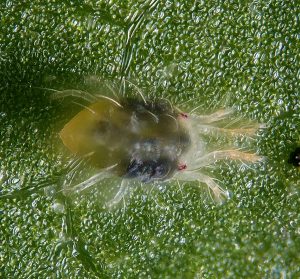
Mites are small arthropods related to insects that belong to subclass Acari, a part of the class Arachnida which also includes spiders, ticks, daddy-longlegs and scorpions. Unlike insects (class Insecta) which have three main body parts and six legs, arachnids have two main body parts and eight legs. There are about 1,200 species of spider mites in the family Tetranychidae. The most common spider mite, the twospotted spider mite (Tetranychus urticae), has a cosmopolitan distribution and has been recorded on more than 300 species of plants, including all of the tree fruit crops, as well as small fruits, vegetables, and ornamentals. Some ornamental plants that commonly become infested include arborvitae, azalea, marigolds, New Guinea impatiens, rose, salvia, spruce, and viola. Vegetables that are often affected include cucumbers, beans, lettuce, peas and tomatoes, and they can also be found on blackberry, blueberry and strawberry.
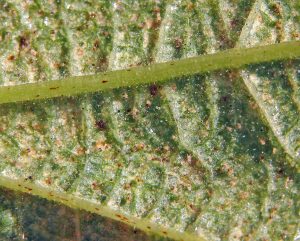
Twospotted spider mites are barely visible with the naked eye – usually only 1/50 inch (0.5 mm) long when mature – as tiny spots on leaves and stems. They range in color from light yellow or green to dark green or brown and at times can be bright red. All have two dark spots visible on the abdomen. Males are smaller and more active than females and have a narrower body with a more pointed abdomen and larger legs. Females lay relatively large, pearl-like eggs in webbing on the underside of the leaves. Unfertilized eggs develop into males while females come from fertilized eggs (a form of parthenogenesis called arrhenotoky).

Each female produces up to 20 eggs per day and a total of up to 120 eggs, depending on the host plant and temperature. The spherical eggs are transparent when first deposited, but gradually turn yellowish. The larvae that hatch from these eggs after 3-15 days (depending on temperature) are colorless and have only 6 legs. The next two nymphal stages (a protonymph and then a deutonymph) are pale yellowish to green with 8 legs, and the two dark spots can be seen. The mites may mature into adults in as few as 5 days during hot, dry weather.
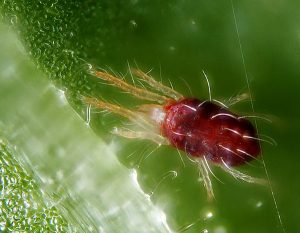
Outdoors, twospotted spider mites overwinter as females resistant to low temperatures under bark or ground cover near their host plants. These diapausing females are bright orange or red and do not feed. Indoors, mites continue to feed and reproduce through the winter but at a slower rate than at other times of the year. Development stops when temperatures are below about 55°F.
The first sign of infestation by twospotted spider mite is usually a chlorotic, stippled appearance on the leaves, although this may not be as apparent on thick-leaved plants. As the mites feed on the underside of leaves, they remove leaf cell contents, including the chlorophyll that gives the leaves their green color. Without the chlorophyll, those empty cells appear whitish or bronze. Heavily infested leaves turn completely pale, dry up, and fall off. Large populations can severely defoliate or kill plants.

The mites also produce fine silken webs over which to crawl. This webbing is where the “spider” part of their common name comes from. The undersurfaces of leaves are often completely covered with webbing. When the mites are numerous, their webbing can cover foliage and flowers, detracting from the appearance of the plant. They move from stem to stem and onto nearby plants on their fine webbing. They can be spread on clothing or tools, and are readily disseminated longer distances on the wind.

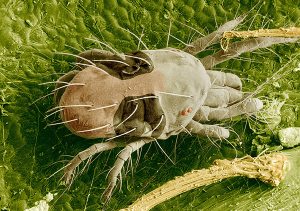
One of the biggest problems with recognizing that spider mites are causing a problem is their small size and the fact that they spend most of their time on the underside of the leaves. Frequently mites are discovered only when damage on the plant becomes noticeable.
In the Midwest, spider mites are not particularly problematic outdoors on most plants. Mites develop best under hot, dry conditions and there is generally high enough humidity to prevent them from doing too well. During periods of drought or in specific microclimates, however, they can be devastating. Even as little as a month without significant rain during the growing season can favor a mite outbreak.
Spider mites thrive on stressed plants. Providing proper growing conditions for optimal plant health and appropriate watering and fertilization, especially when the weather is hot and dry, will help reduce problems.

Indoors, especially in greenhouses, twospotted spider mite can be a difficult pest to control. Frequent visual inspection of plant parts is the best way to keep track of whether mites are developing on plants. They can be found on all areas of the plant but they most often infest the older, middle-age leaves, and the midrib. Spider mites can also be monitored by tapping leaves or other plant parts over a sheet of white paper or cardboard and then watching for moving specks on the paper. Once their feeding damage or webbing becomes apparent, populations are already well-established and more difficult to control. On houseplants spider mites often become a problem in November when the heat comes on and the air is drier.

Predatory mites of the family Phytoseiidae are the most important predators of spider mites. Naturally-occurring species often keep spider mites under control on outdoor plants. They are also the most commonly used commercially available natural enemies for controlling spider mites in greenhouses. In hobby greenhouses they will be effective only if the humidity is generally above 70%. They are not recommended, however, for controlling heavy infestations indoors, or problems on individual plants.
Although a forceful stream of water can be used wash away some of the mites and their webbing, chemical control is often the best option for managing spider mites. Insecticidal soaps are very effective and should be the first choice for most spider mite problems; horticultural oil may also be effective (not dormant oil) but applications need to be made frequently. Soap and oil have no residual activity and only affects the mites it is sprayed directly on, so thorough coverage of the foliage and repeated applications are essential. Most of the mites are on the underside of the leaves, so that’s where the spray needs to be applied. Synthetic chemicals with residual activity can be used when there is no danger of children or pets contacting the leaves. Most insecticides no longer work against spider mites because of resistance problems. Products called miticides (or acaricides) are made to control spider mites, but these products can be hard to find or are not sold to homeowners.
– Susan Mahr, University of Wisconsin – Madison





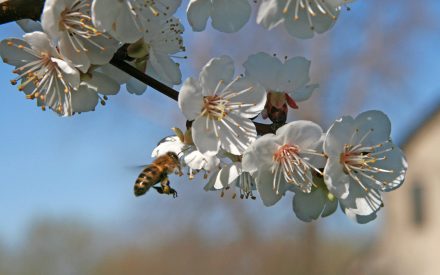 What’s All the Buzz? Woody Plants for Bees, Butterflies, and Other Bee-t-full Pollinators
What’s All the Buzz? Woody Plants for Bees, Butterflies, and Other Bee-t-full Pollinators ▶︎ Watch: Hydrangeas: Know Them and Grow Them
▶︎ Watch: Hydrangeas: Know Them and Grow Them Promoting Urban Forestry: Planting Bareroot Trees in Home Landscapes
Promoting Urban Forestry: Planting Bareroot Trees in Home Landscapes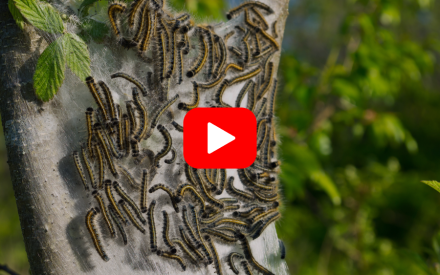 ▶︎ Watch: Torching Tent Caterpillars
▶︎ Watch: Torching Tent Caterpillars


